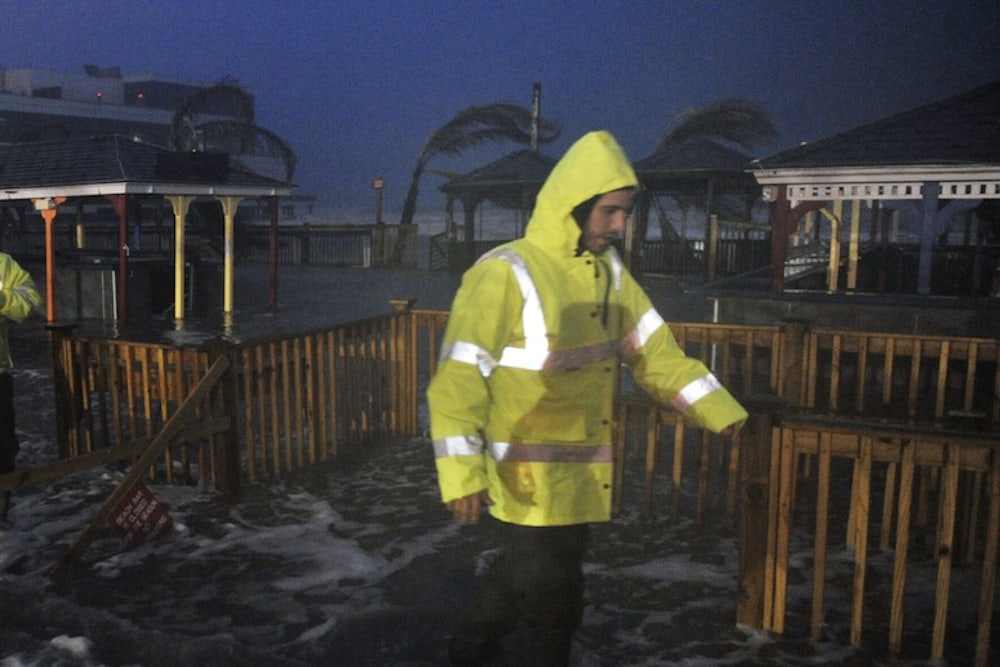When Sarah Silverman posts jokes about the Holocaust to YouTube, she gets millions of page views. When Prince Harry dressed up as a Nazi, he got blasted by the international press. Why can Sarah—but not Harry—get away with it? Comedians make an art of toeing the line between racy and funny, but for those of us who’ve ever wondered whether or not the world is ready for our witty take on the latest tragedy, science is here to help: psychologists have devised a formula showing the point at which it becomes funny to make a joke about a real-life disaster.
For a new paper in the journal Social Psychological and Personality Science, a team of psychologists led by University of Colorado—Boulder professor Peter McGraw looked at how people’s reactions to jokes about Hurricane Sandy changed over time. McGraw recruited participants at ten intervals, from the day before Sandy was expected to hit to four months after the event, and asked them to read tweets from the parody account @AHurricaneSandy:
Over the course of the study, over a thousand people weighed in, ranking each tweet on a one-to-seven scale and registering whether they found it funny, upsetting, offensive, boring, irrelevant or confusing.
“Humorous responses to Sandy’s destruction rose, peaked, and eventually fell over the course of 100 days,” wrote McGraw. “We find that temporal distance creates a comedic sweet spot. A tragic event is difficult to joke about at first, but the passage of time initially increases humor as the event becomes less threatening. Eventually, however, distance decreases humor by making the event seem completely benign.”
Before the hurricane hit, when the danger was still hypothetical, people thought the tweets were pretty funny: They gave them, on average, between 3 and 4 points on the 1 to 7 scale. But when Sandy arrived and people realized the extent of the damage it had wrought, humor declined, reaching a low point 15 days after Sandy’s landfall. As time passed, though, it became more and more acceptable to “find humor in the tragedy,” and people’s rankings climbed—reaching a peak 36 days after landfall. After this point, humor dropped off again, reaching a new low at Day 99.
McGraw’s results make sense in light of the “benign violation theory” of humor:
The benign violation theory explains why psychological distance helps humor up to a point but suggests that too much distance hurts humor...Distance reduces threat, helping transform tragedy (a violation) into comedy (a benign violation), but too much distance can make comedy seem tame and uninteresting (a benign situation)…Research and intuition suggest that each form of psychological distance increases humorous responses to highly aversive situations (McGraw et al., 2012). For example, disgusting things are more amusing when they are ostensibly fake, seem far away in space or time, or afflict someone else.
But if the situation is only “mildly aversive,” psychological distance reduces funniness:
Whereas people report that getting hit by a car would be more humorous if it occurred 5 years ago than if it happened yesterday, they also report that stubbing a toe would be more humorous if it occurred yesterday than if it happened 5 years ago….The benign violation theory highlights the two ways a situation can fail to be humorous. A situation may be purely violating (e.g., being tickled by a creepy stranger) or purely benign (e.g., tickling oneself); neither produces humor. Humor requires threat but not too much or too little.
Of course, psychological distance isn’t the only variable affecting people’s response to jokes; there’s also the small matter of whether or not it’s funny.
“The more delicate the subject, the more skilled the humorist should be,” said McGraw. “That’s why new comedians use scatological humor—there’s nothing delicate about it.”
But The Onion, McGraw pointed out, put out a “9/11 issue” just two weeks after the event—and it turned out to be one of their most widely celebrated editions. “People were incredibly grateful to The Onion,” said McGraw. “There was sort of this no-comedy zone that happened after 9/11 and it wasn't clear when it would be okay to begin making jokes again. People didn’t say it was ‘too soon’ because it was so funny.
McGraw believes the spread of social media has imposed new limits on what comedians can get away with.
“Comedy is a space that has its own set of rules,” said McGraw. “Then it gets posted on the Internet and broadcast to people sitting at their desks— people who weren’t intended to hear it and aren’t in the mindset to appreciate it.”
